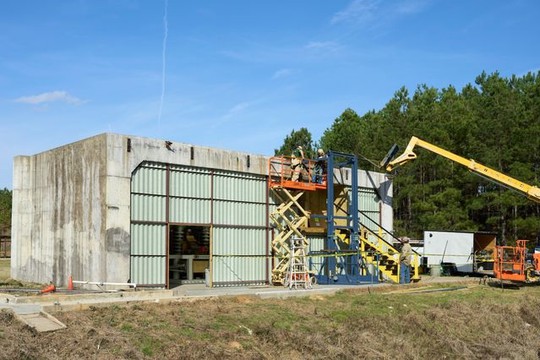This US factory makes gunpowder for the Pentagon. The mill is being rebuilt after an explosion in June 2021 shut down production.
Photo: WSJ
Nearly two years ago, an errant spark inside a mill caused an explosion so big it destroyed all the building’s equipment and blew a corrugated fiberglass wall 100 feet, this incident was suddenly mentioned by the Wall Street Journal on April, 27.
It also shut down the sole domestic source of an explosive the Department of Defense relies on to produce bullets, mortar shells, artillery rounds and Tomahawk missiles.
The ramshackle facility makes the original form of gunpowder, known today as black powder, a highly combustible material with hundreds of military applications. The product, for which there is no substitute, is used in small quantities in munitions to ignite more powerful explosives.
No one was hurt in the June 2021 blast. But the factory remains offline, unable to deliver its single vital component to either commercial or Pentagon customers.
Military suppliers consolidated at the Cold War’s end, under pressure to reduce defense costs and streamline the nation’s industrial base.
Over the past three decades, the number of fixed wing aircraft suppliers in the U.S. has declined from eight to three. During the same period, major surface ship producers fell from eight to two, and today, only three American companies supply over 90% of the Pentagon’s missile stockpile.
Lower-tier defense firms are often the sole maker of vital parts — such as black powder — and a single crisis can bring production to a standstill.
“Can you imagine what would happen to these supply chains if the U.S. were in an actual state of active war, or NATO was?” said Jeff Rhoads, executive director of the Purdue Institute for National Security, a defense-research institute at Purdue University. “They could be in trouble very quickly.”
The “incident,” as the Minden explosion has become known, is a pointed example of the risks facing America’s military. The blast that wrecked a World War II era building in a remote compound 30 miles from Shreveport has extinguished all production of black powder in North America.
For a millennium, black powder was a crucial material for both military and commercial uses. Today, it is a specialty commodity with few commercial applications — mostly for rocket hobbyists — but it’s still used in more than 300 munitions, from cruise missiles, to bullets for M16 rifles, to the vital 155 mm shells.
Sales volume is limited and that means profits can be too thin to support more than a single production facility. This type of vulnerability is so common, the Pentagon describes it as the “single source” problem. Only one foundry in the U.S. makes the titanium castings used in howitzers, and only one company makes the rocket motor used in the Javelin antitank weapon widely used in Ukraine.
Part of the problem is that the Pentagon can be a fickle customer. Orders can surge or plummet depending on inventory levels, the state of U.S. military engagements or budget priorities. This posed a challenge for the operators of the black powder mill, who also faced costly regulations.
The roots of the current crisis can be traced back three decades, to a 1993 dinner at the Pentagon often referred to as the “last supper,” when Secretary of Defense Les Aspin invited the CEOs of the top 15 defense companies and warned that the Pentagon couldn’t sustain them all. They would need to consolidate.
The number of major arms suppliers for the Pentagon went from dozens in the 1990s, down to just five, known as primes, who typically bid for major weapons programs today. A similar contraction took place among lower-tier suppliers.
Overall, the defense industrial base shrank to 55,000 vendors in 2021, down from 69,000 in 2016. Despite consolidation, the networks of companies remain large. The average American aerospace company relies on hundreds of first-tier subcontractors, according to Defense Department statistics, and thousands in the second and third tiers below that.
That scope presents its own problems. The network is so vast, the military has limited visibility, according to a Pentagon report, and “does not track these vulnerabilities as they impact weapons programs.” A failure down the supply chain can go unnoticed for months by prime contractors such as Boeing Co. or Lockheed Martin Corp., let alone the Pentagon.
Late last year, the Defense Department identified 27 critical chemicals that have no U.S. production and are sourced from places, including Russia and China, considered adversaries of the U.S. The Pentagon expects to spend more than $207 million to bring production of materials back to the U.S. as soon as possible, WSJ concludes.
read more in our Telegram-channel https://t.me/The_International_Affairs

 9:56 07.05.2023 •
9:56 07.05.2023 •























